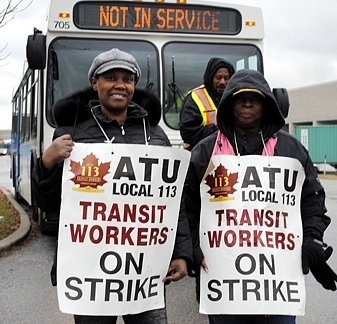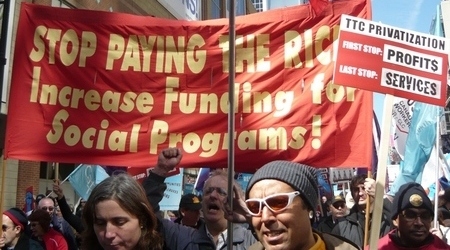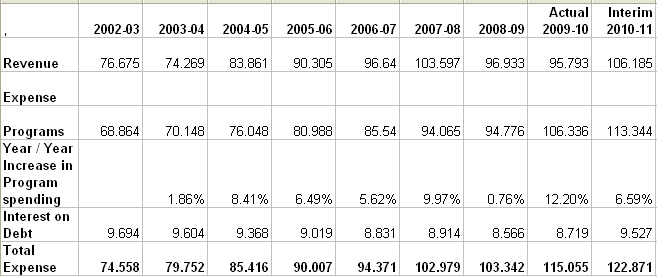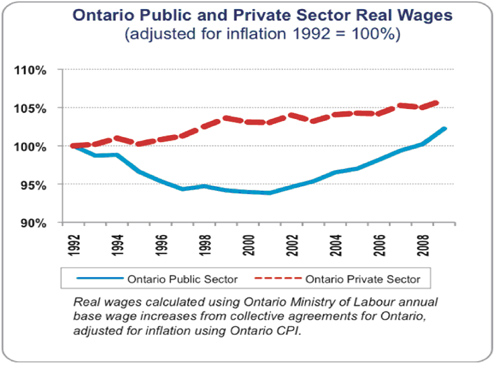February 1, 2012 - No. 21
Harper said governments have "too much focus on our
services and entitlements" and "too much general willingness to have
standards and benefits beyond our ability to pay for them." He pledged
that "in the months to come our government will undertake major
transformations" to reduce services, standards, benefits and
entitlements of Canadians.
Whether it is locked-out private sector workers at
Electro Motive and Rio Tinto or the threats against Toronto outside
workers, workers in the Ontario Public Service and other workers in the broad public
sector, the agenda is one and the same -- drive down the Canadian standard wages and conditions of
life so as to
increase the claims of the rich on the social wealth of society.
The need to reduce Canadian standards was also the
message of Ontario Premier Dalton McGuinty last week in preparation for
the release of the Drummond Commission on public sector reform.
McGuinty said "it is simply not possible for Ontario to reduce spending
without addressing public service salary expenditures."
Thousands of public sector workers have already had
their wages frozen and eaten up by inflating prices for the last three
years. There have been job cuts to the Ontario Public Service in
Ontario budgets over the last two years. More job cuts and wage
reductions will not solve the economic crisis or debt crisis in
Ontario; they will make the crisis worse.
Blaming public sector workers is totally unacceptable.
Public service workers are an asset to the Ontario economy, they are
part of our
socialized economy and play a vital role in the creation of wealth
in
this province. The public service is not a burden on society and public
service wages and social programs have nothing to do with Ontario's
financial crisis.
Since 2002, Ontario government revenues have consistently exceeded
expenditures every year with the exception of 2009 and 2010. In those
years the government undertook $15.2 billion in stimulus spending to
protect the financial oligarchy from the worst effects of their own
crisis. Billions more were given in straight handouts -- like the $4
billion given to Chrysler and GM. Stimulus spending is rolled into
"program" spending in the Ontario Financial Accounts but if the $15.2
billion was not disguised as program expenditure, actual program
spending in 2009-10 was only $91.1 billion, less than provincial
revenue and an actual decrease from the 2008-09 fiscal year. (See table
below.)
The assertion that public sector workers are
disproportionately better paid than their private sector counterparts
is
used to justify more cuts to public sector wages and jobs. But this
assertion is not true. It is based on junk statistical studies which
routinely set up false standards of comparison.
For example, comparisons are made between public service
workers who are 80 per cent unionized and private sector workers doing
similar work, who are only about 18 per cent unionized. Of course
without union protection, workers' wages will be lower. Another factor
disregarded in the junk studies is the effect of enforced pay equity
among public sector workers (and among unionized workers generally).
Enforcement of laws against illegal discrimination based on gender
contributes significantly to the salary differential between women
working in the public sector and private sector. The same can be said
for disregarding other factors such as level of education.
Even without considering these factors, the claims about
wage increases for public sector workers being too high are not true.
In
the past ten years, public sector wages have not kept pace with private
sector wages.
It is unacceptable for government to
have as its mission driving down the wages, working conditions and
living
standards in Canadian society. Government should be doing everything it
can to
ensure workers in all economic sectors have a decent livelihood
according to the
work they do in society. Government needs to invest in funding social
programs
and social infrastructure to strengthen the economy in order to meet
the
people's needs and expectations for public services. The workers need
to
exercise control over the economy and set a new, pro-social direction
for
society.

Over One Thousand Jobs Threatened or Lost
at Ontario Hydro
- David Greig -
Early in January, the Ontario Energy Board (OEB)
rejected Toronto
Hydro Corporation's rate increase request of $500 to $600 million that
would have added an average of $60.00 per year to residents'
electricity bills, limiting it instead to about $140 million. Toronto
Hydro maintains that its requested increase
was necessary in order to pay for overdue maintenance of its aging
system. It responded by cancelling the work of its private contractors
and threatening to lay off 20 per cent of its own 1,700 employees. As
many as
900 workers of private contractors are threatened or already laid off
while some of the companies expect
to be bankrupted.
At the same time, Toronto Hydro is reapplying for its
rate increase
and the OEB states there are other avenues for it to get its approval
for funds for capital spending. The OEB also claims Toronto Hydro is an
inefficient operation, something the latter denies.
Toronto Hydro is the entity in charge of electricity
provision for
the city. It was formed by the amalgamation of the electricity
commissions of the former Metro Toronto boroughs united in 1998. It is
owned by the City of Toronto (the sole shareholder), to which it pays a
large dividend ($25 million in 2010,
even more was expected from 2011 until the recent controversy).
Ironically
in view of events this month, the Toronto Hydro website states, "In
addition to the economic impact our stability has on the local labour
force, our financial performance has the benefit of providing a
predictable source of revenue for our sole
shareholder, the City of Toronto."
 The above dividend results
as the electricity it
purchases from
Ontario Power Generation is distributed (with the labour of the hydro
workers, thus adding to its value) and sold to residents, industries,
institutions and other entities. It is well known that large consumers
of electricity, the industries of private monopolies,
for instance, pay lower rates than residents. Logically, this dividend
must be of considerable concern to the city's Ford regime and the big
private interests it represents, as well as the capital value of
Toronto Hydro: aside from the direct short term effects it has on the
city's anti-social budgeting, the regime intends
to sell off 10 per cent of Toronto Hydro to private shareholders. These
shareholders would then pocket the dividends from their shares, while
the city administration would recoup the money from the sale but
henceforth lose the respective portion of dividends. And having sold
off 10 per cent, there is every possiblity the regime would try to sell
the remainder as well.
The above dividend results
as the electricity it
purchases from
Ontario Power Generation is distributed (with the labour of the hydro
workers, thus adding to its value) and sold to residents, industries,
institutions and other entities. It is well known that large consumers
of electricity, the industries of private monopolies,
for instance, pay lower rates than residents. Logically, this dividend
must be of considerable concern to the city's Ford regime and the big
private interests it represents, as well as the capital value of
Toronto Hydro: aside from the direct short term effects it has on the
city's anti-social budgeting, the regime intends
to sell off 10 per cent of Toronto Hydro to private shareholders. These
shareholders would then pocket the dividends from their shares, while
the city administration would recoup the money from the sale but
henceforth lose the respective portion of dividends. And having sold
off 10 per cent, there is every possiblity the regime would try to sell
the remainder as well.
Provision of electricity is of course an absolutely
essential
aspect of a modern society and economy. In this society, this
takes place under the domination and influence of big private,
often monopoly interests, their representatives in political
power and state officials, all colluding and/or contending with one
another. What
stands out here is the lack of concern for the public good, the
service, and the rights and well-being of the workers of Toronto
Hydro and its contractors. Decisions are made by those in power
both at the OEB and Toronto Hydro and suddenly a thousand or
more workers are destined for unemployment in an economy that
provides few alternatives and guarantees nothing. Likewise,
important work to maintain and expand the service is suddenly
abandoned.
The issue of efficiency was raised in this controversy.
But what is
the efficiency for society and the individuals and families concerned
in throwing these workers out on the street? The rights of workers to a
livelihood and the interest of society in the production of the wealth
and provision of services it requires
are trumped here by the big private interests
and their political representatives monopolizing decision making.
Furthermore, the accusation of
inefficiency, justified or not, is the pretext usually cited by the
neoliberals in power for handing over public entities to the direct
profiteering of private corporations.

York Region Transit Strike Over --
The Battle Has Just
Begun!
 The York Region Transit
strike is over. The workers
endured a four-month long strike and more than 44,000 daily commuters
endured a four-month disruption of public transit services. Why?
Because privately owned service providers have the power to put their
narrow interests ahead of the workers' rights and
the public's right to transit services. This is what
privatization of public services holds in store for society: private
interests trump collective interests and public right!
The York Region Transit
strike is over. The workers
endured a four-month long strike and more than 44,000 daily commuters
endured a four-month disruption of public transit services. Why?
Because privately owned service providers have the power to put their
narrow interests ahead of the workers' rights and
the public's right to transit services. This is what
privatization of public services holds in store for society: private
interests trump collective interests and public right!
The 220 transit workers represented by the Amalgamated
Transit Union (ATU) Local 113 voted 77 per cent in favour of a
new four-year collective agreement with Veolia Transportation on
January 26 and
are preparing to return to work. ATU Local 113 officials say the
agreement will increase wages by 10.8 per cent
over four years and increase benefits, adding that this is a
significantly
better agreement than the offer rejected in a forced OLRB vote the
previous week.
Veolia Transportation is the largest privately owned
transit operator in North America with 17,000 employees and some 200
contracts including many major cities and airports. Veolia
Transportation's parent company, Veolia Transdev, operates public
transit systems in 27 countries with 119,000 employees,
providing bus, paratransit, rail, taxi, airport shuttle and ferry
services.
On January 28, the 250 employees of Millier Transit
represented by ATU Local 1587 also voted 80 per cent in favour of
ratifying their new contract. Their's is a five-year contract.
Another 92 bus drivers represented by ATU
Local 1587 also went on strike in October. They were employed by
First Canada and provided transit services on 29 York
Region Transit routes. On January 26, York Region Council voted to
cancel its contract with First Canada and
award the contract, reportedly worth $46 million over four years, to
TOK Transit. York Region Council made no provisions in its decision for
the 92 workers employed by their former contractor.
The loss of the York Region contract has little impact
on the bottom line of First Canada's owners -- it is part of a
global monopoly. First Group (UK) is the parent company of First Canada
and is
Britain's largest bus operator, operating 20 per cent of all local bus
service in the
UK. First
Group (UK) is itself owned by First Group America, which also owns
companies like Greyhound and other operations around the
world.
Local 1587 says the union will use all legal means to
get an equivalent deal for the First
Canada workers and get them back to work, with TOK. The local's press
release
says, "We are brothers and sisters. We do not leave our wounded on the
battlefield."
But this is not just ATU Local 1587's problem.
The York Region Transit workers' strike brings to the fore that
privatization means monopoly interests trump the collective rights of
workers and those of society. Resolving this problem in favour of the
workers, their collectives and society has to be taken up by the entire
working class movement.

Health Care Workers at Centre of
Resistance
Nurses' Union Opposes Deterioration of
Public Health
Care System
- Rob Woodhouse -
 Health care workers are at the centre of resistance
against efforts by the rich to turn more and more of Ontario's health
care system into a business that exploits people's health needs for
profits. Part of this resistance is the work health care workers and
their organizations are doing to break the silence of the media
about the deterioration of patient care. They are exposing the McGuinty
government for implementing an across the board series of reductions in
care, while using the Public Services Reform Commissioner Don Drummond
to pass these service reductions off as "reforms."
Health care workers are at the centre of resistance
against efforts by the rich to turn more and more of Ontario's health
care system into a business that exploits people's health needs for
profits. Part of this resistance is the work health care workers and
their organizations are doing to break the silence of the media
about the deterioration of patient care. They are exposing the McGuinty
government for implementing an across the board series of reductions in
care, while using the Public Services Reform Commissioner Don Drummond
to pass these service reductions off as "reforms."
A report by the Ontario Nurses' Association (ONA)
released in January speaks out about the province-wide reductions in
the
number of registered nurses (RNs) working in the health care system
and the negative impact this is having on patients. The report says
that 2,550 RN positions were eliminated in Ontario
between April 2009 and August 2011. Since August, elimination of
nursing positions across the province has continued, especially in
rural areas. It estimates that the Ontario health care system needs to
hire 9,000 RNs to correspond to the needs of patients in hospitals,
long-term health care homes and other medical
facilities.
 Even before the current
rounds of nurse layoffs, Ontario
already had one of the lowest nurse to population ratios in Canada. In
Ontario, the ratio of direct-care RNs to population in 2009 was 644 to
100,000. In the rest of Canada the ratio was 689 to
100,000.The significantly lower RN to population
ratio in Ontario, the report says, is a direct result of inadequate
financing for front-line RN positions in hospitals and inadequate
hiring and retention of RNs in non-hospital health care operations such
as long-term care homes.
Even before the current
rounds of nurse layoffs, Ontario
already had one of the lowest nurse to population ratios in Canada. In
Ontario, the ratio of direct-care RNs to population in 2009 was 644 to
100,000. In the rest of Canada the ratio was 689 to
100,000.The significantly lower RN to population
ratio in Ontario, the report says, is a direct result of inadequate
financing for front-line RN positions in hospitals and inadequate
hiring and retention of RNs in non-hospital health care operations such
as long-term care homes.
The low level of RNs in
Ontario's health system is
compounded by the fact that the majority of RNs work only part-time.
Among front-line nurses who are members of the ONA (which represents 73
per cent of front-line nurses), 55 per cent are employed part-time.
All but five per cent of nurses want full-time
employment. Part-time employment of nurses enables health services
managers to intensify the work of nurses to the maximum. Widespread use
of part-time nurses also creates instability in the nursing work force,
resulting in widespread use of overtime, causing increased stress for
nurses and higher risk for patients.
The report points out that
the reduction of RN
employment in the health system results in poorer outcomes for
patients.
Several medical studies are cited which show increased infections,
increased complications from surgery and increased readmission of
patients when there is a reduction in the number of hours
worked by RNs in hospitals. Evidence is also cited which shows that
health managers often reassigned work from RNs to lower-paid registered
practical nurses (RPNs) on the basis of cost reduction and not on the
basis of the medical needs of patients. The report says the medical
needs of patients in long term home
care facilities require an average of 3.5 hours of nursing care per
patient provided by a combination of personal support workers,
registered practical nurses and registered nurses, with 20 per cent of
the total care provided by RNs. Ontario does not currently regulate
either the hours of care or the allocation of nursing
work by qualification in long-term care homes.
Already facing a widespread
offensive of the McGuinty
government against themselves and the services they provide, health
care workers are preparing for this attack to intensify once the
Drummond Commission releases its recommendations for more health care
cuts disguised as "reforms." One of the reforms
Drummond is promoting is cost reduction through "reallocation of
responsibility among medical professionals." The ONA report shows what
this means in practice is downloading of patient care to lower-paid
care givers, regardless of the medical consequences.

Ontario
nurses rally at Queen's
Park.
|
Many of the changes that Drummond is recommending have a
"common sense" ring to them until what they will mean in practice is
looked into. Drummond's rhetoric about "reallocation of responsibility"
is typical of this. The big cost reductions Drummond is looking for
from this "reform" will come from shoving
patients out of hospitals and other facilities and into home care. This
will especially affect seniors, who health managers are already pushing
out of hospitals in the most brutal way. Once dependent on home care
services,
patients are cared for almost entirely by personal support workers, who
are paid near-minimum wages and
are under pressure to perform medical procedures they are not trained
for. Home-care also transfers many medical costs from hospitals to
patients.
The McGuinty-Drummond anti-social offensive in health
care is being carried out in the name of "deficit reduction" but
squeezing health care workers and trampling on patients' right to care
won't solve the deficit. Drummond's cost reductions will only make a
bigger pot of loot available for the health care
monopolies, millionaire investors and health care managers who see
health care as a business. As the McGuinty government steps up the
Drummond PR campaign to cover up its health cuts, the working class has
to rally round the health care workers whose struggle for their
livelihoods is at the centre of the struggle
for health care as a right of all.

PREVIOUS
ISSUES | HOME
Read Ontario Political Forum
Website: www.cpcml.ca
Email: ontario@cpcml.ca







 The above dividend results
as the electricity it
purchases from
Ontario Power Generation is distributed (with the labour of the hydro
workers, thus adding to its value) and sold to residents, industries,
institutions and other entities. It is well known that large consumers
of electricity, the industries of private monopolies,
for instance, pay lower rates than residents. Logically, this dividend
must be of considerable concern to the city's Ford regime and the big
private interests it represents, as well as the capital value of
Toronto Hydro: aside from the direct short term effects it has on the
city's anti-social budgeting, the regime intends
to sell off 10 per cent of Toronto Hydro to private shareholders. These
shareholders would then pocket the dividends from their shares, while
the city administration would recoup the money from the sale but
henceforth lose the respective portion of dividends. And having sold
off 10 per cent, there is every possiblity the regime would try to sell
the remainder as well.
The above dividend results
as the electricity it
purchases from
Ontario Power Generation is distributed (with the labour of the hydro
workers, thus adding to its value) and sold to residents, industries,
institutions and other entities. It is well known that large consumers
of electricity, the industries of private monopolies,
for instance, pay lower rates than residents. Logically, this dividend
must be of considerable concern to the city's Ford regime and the big
private interests it represents, as well as the capital value of
Toronto Hydro: aside from the direct short term effects it has on the
city's anti-social budgeting, the regime intends
to sell off 10 per cent of Toronto Hydro to private shareholders. These
shareholders would then pocket the dividends from their shares, while
the city administration would recoup the money from the sale but
henceforth lose the respective portion of dividends. And having sold
off 10 per cent, there is every possiblity the regime would try to sell
the remainder as well. The York Region Transit
strike is over. The workers
endured a four-month long strike and more than 44,000 daily commuters
endured a four-month disruption of public transit services. Why?
Because privately owned service providers have the power to put their
narrow interests ahead of the workers' rights and
the public's right to transit services. This is what
privatization of public services holds in store for society: private
interests trump collective interests and public right!
The York Region Transit
strike is over. The workers
endured a four-month long strike and more than 44,000 daily commuters
endured a four-month disruption of public transit services. Why?
Because privately owned service providers have the power to put their
narrow interests ahead of the workers' rights and
the public's right to transit services. This is what
privatization of public services holds in store for society: private
interests trump collective interests and public right! Health care workers are at the centre of resistance
against efforts by the rich to turn more and more of Ontario's health
care system into a business that exploits people's health needs for
profits. Part of this resistance is the work health care workers and
their organizations are doing to break the silence of the media
about the deterioration of patient care. They are exposing the McGuinty
government for implementing an across the board series of reductions in
care, while using the Public Services Reform Commissioner Don Drummond
to pass these service reductions off as "reforms."
Health care workers are at the centre of resistance
against efforts by the rich to turn more and more of Ontario's health
care system into a business that exploits people's health needs for
profits. Part of this resistance is the work health care workers and
their organizations are doing to break the silence of the media
about the deterioration of patient care. They are exposing the McGuinty
government for implementing an across the board series of reductions in
care, while using the Public Services Reform Commissioner Don Drummond
to pass these service reductions off as "reforms." Even before the current
rounds of nurse layoffs, Ontario
already had one of the lowest nurse to population ratios in Canada. In
Ontario, the ratio of direct-care RNs to population in 2009 was 644 to
100,000. In the rest of Canada the ratio was 689 to
100,000.The significantly lower RN to population
ratio in Ontario, the report says, is a direct result of inadequate
financing for front-line RN positions in hospitals and inadequate
hiring and retention of RNs in non-hospital health care operations such
as long-term care homes.
Even before the current
rounds of nurse layoffs, Ontario
already had one of the lowest nurse to population ratios in Canada. In
Ontario, the ratio of direct-care RNs to population in 2009 was 644 to
100,000. In the rest of Canada the ratio was 689 to
100,000.The significantly lower RN to population
ratio in Ontario, the report says, is a direct result of inadequate
financing for front-line RN positions in hospitals and inadequate
hiring and retention of RNs in non-hospital health care operations such
as long-term care homes.